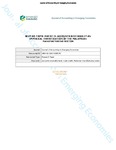WHY DO FIRMS INVEST IN ACCOUNTS RECEIVABLE? AN EMPIRICAL INVESTIGATION OF THE MALAYSIAN MANUFACTURING SECTOR
| dc.contributor.author | Paul, S | |
| dc.contributor.author | Guermat, C | |
| dc.contributor.author | Devi, S | |
| dc.date.accessioned | 2018-03-21T07:13:02Z | |
| dc.date.available | 2018-03-21T07:13:02Z | |
| dc.date.issued | 2018-05-08 | |
| dc.identifier.issn | 2042-1168 | |
| dc.identifier.issn | 2042-1176 | |
| dc.identifier.uri | http://hdl.handle.net/10026.1/11123 | |
| dc.description.abstract |
<jats:sec><jats:title content-type="abstract-subheading">Purpose</jats:title><jats:p>The purpose of this paper is to investigate the factors that influence Malaysian manufacturing sector investment in accounts receivable (AR), an asset seen by many as one of the riskiest in any company’s balance sheet.</jats:p></jats:sec><jats:sec><jats:title content-type="abstract-subheading">Design/methodology/approach</jats:title><jats:p>The authors test several theories, related to AR, using a cross-section of 262 listed manufacturing firms over a period of five years (2007-2011). Both fixed and random effect approaches are adopted to deal with potential heterogeneity across firms.</jats:p></jats:sec><jats:sec><jats:title content-type="abstract-subheading">Findings</jats:title><jats:p>The results show that investment in AR in Malaysia are influenced by firm size, short-term finance, sales growth and collateral. Profit, liquidity and gross margins have no role in affecting the decision of trade credit granting to customers. The results are inconsistent with previous studies. Size and short-term finance have a negative, rather than positive, impact. Liquidity and gross margins have no, rather than positive, effect. While profit and sales growth are predicted to feature a U-shaped relationship with investment in AR, the former is insignificant while the latter is strictly increasing. The only factor found to be consistent with prior studies is collateral.</jats:p></jats:sec><jats:sec><jats:title content-type="abstract-subheading">Research limitations/implications</jats:title><jats:p>The results have two principal implications. First, policy makers should not take a holistic view of the trade credit market. Given that policy makers aim to improve liquidity and trade, they should design policies that are not only country specific but also sector specific. As is clear from our results, what holds for other countries or sectors may not necessarily be true for the Malaysian manufacturing sector. This has important implications for policy makers in emerging economies.</jats:p></jats:sec><jats:sec><jats:title content-type="abstract-subheading">Practical implications</jats:title><jats:p>Investment in AR, in the Malaysian manufacturing sector, is impacted by many of the factors implied by either theory or empirical evidence. However, the main finding in this paper is that the Malaysian manufacturing sector is rather different. First, while liquidity and gross margin have been found to have a positive and significant effect on AR helping hand theory in prior studies, the results show that these two factors play no role in influencing the level of AR in the Malaysian manufacturing sector.</jats:p></jats:sec><jats:sec><jats:title content-type="abstract-subheading">Social implications</jats:title><jats:p>Unlike the experience in developed economies, firms in our sample that have access to short-term finance are less likely to grant trade credit. This suggests that the helping hand theory does not hold as far as the Malaysian manufacturing firms are concerned: firm that have better access to short-term finance in Malaysia do not use trade credit to pass on the benefit to their customers by granting them trade credit.</jats:p></jats:sec><jats:sec><jats:title content-type="abstract-subheading">Originality/value</jats:title><jats:p>It is unclear why firms invest in AR given the high risks of uncollectability as well as tedious, time-consuming and costly legal process for debt recovery compared to firms from more developed economies. This paper examines the reasons business-to-business lending, through AR, is widespread in Malaysia and investigates the factors that affect this decision despite the risk involved. To our knowledge, this is the first study to date that looks at the factors that influence AR level in the Malaysian manufacturing sector.</jats:p></jats:sec> | |
| dc.format.extent | 166-184 | |
| dc.language | en | |
| dc.language.iso | en | |
| dc.publisher | Emerald Publishing | |
| dc.rights | Attribution 4.0 International | |
| dc.rights | Attribution 4.0 International | |
| dc.rights | Attribution 4.0 International | |
| dc.rights | Attribution 4.0 International | |
| dc.rights | Attribution 4.0 International | |
| dc.rights | Attribution 4.0 International | |
| dc.rights | Attribution 4.0 International | |
| dc.rights.uri | http://creativecommons.org/licenses/by/4.0/ | |
| dc.rights.uri | http://creativecommons.org/licenses/by/4.0/ | |
| dc.rights.uri | http://creativecommons.org/licenses/by/4.0/ | |
| dc.rights.uri | http://creativecommons.org/licenses/by/4.0/ | |
| dc.rights.uri | http://creativecommons.org/licenses/by/4.0/ | |
| dc.rights.uri | http://creativecommons.org/licenses/by/4.0/ | |
| dc.rights.uri | http://creativecommons.org/licenses/by/4.0/ | |
| dc.title | WHY DO FIRMS INVEST IN ACCOUNTS RECEIVABLE? AN EMPIRICAL INVESTIGATION OF THE MALAYSIAN MANUFACTURING SECTOR | |
| dc.type | journal-article | |
| dc.type | Journal Article | |
| plymouth.issue | 2 | |
| plymouth.volume | 8 | |
| plymouth.publication-status | Published | |
| plymouth.journal | Journal of Accounting in Emerging Economies | |
| dc.identifier.doi | 10.1108/JAEE-01-2017-0005 | |
| plymouth.organisational-group | /Plymouth | |
| plymouth.organisational-group | /Plymouth/Faculty of Arts, Humanities and Business | |
| plymouth.organisational-group | /Plymouth/Faculty of Arts, Humanities and Business/Plymouth Business School | |
| plymouth.organisational-group | /Plymouth/REF 2021 Researchers by UoA | |
| plymouth.organisational-group | /Plymouth/REF 2021 Researchers by UoA/UoA17 Business and Management Studies | |
| plymouth.organisational-group | /Plymouth/Users by role | |
| plymouth.organisational-group | /Plymouth/Users by role/Academics | |
| dcterms.dateAccepted | 2017-11-25 | |
| dc.identifier.eissn | 2042-1176 | |
| dc.rights.embargoperiod | Not known | |
| rioxxterms.version | Accepted Manuscript | |
| rioxxterms.versionofrecord | 10.1108/JAEE-01-2017-0005 | |
| rioxxterms.licenseref.uri | http://creativecommons.org/licenses/by/4.0/ | |
| rioxxterms.licenseref.startdate | 2018-05-08 | |
| rioxxterms.type | Journal Article/Review |



